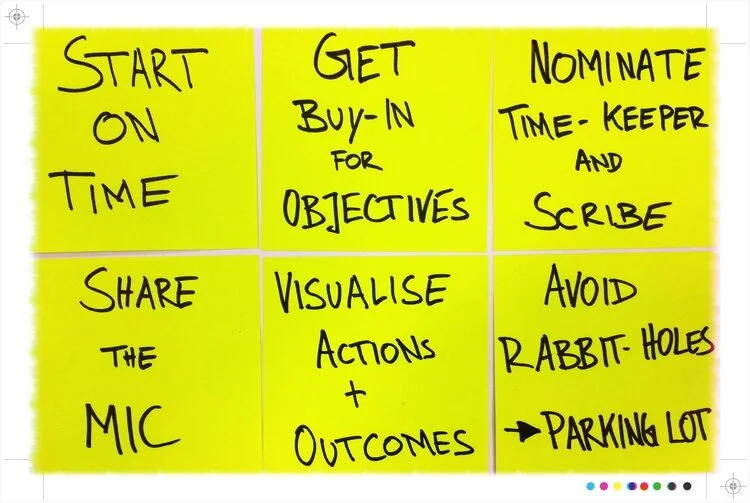Why are most meetings still so ineffective?
The understatement of the year: meetings are often not quite as effective as they should be.
You can find hundreds of blog posts on the topic, from Forbes, Inc, Wikihow and Quora only to name a few. These posts usually cover the same topics, most commonly the need to have an objective, agenda, the right people in the room, actions at the end, starting and ending on time.
At Pragmateam we recently asked participants in a training session on the topic to list all the things that make meetings ineffective; before, during and after the meeting occurs. The group then worked through the list and found remedies for each one.
The entire exercise took 15min. The participants smashed through it because everyone knows what an effective meeting looks like, what factors prevent and contribute to one. Everyone. Knows.
So why don’t effective meetings occur more often? Why is it still the stuff of Dilbert comics and prompts a knowing smile from everyone in the room when the topic comes up?
Before the meeting
1. A good meeting requires preparation from the meeting organiser, which means it takes more time upfront.
A well prepared meeting consists of a few things, all of which take time, and all of which are considered so obvious and plain standard that typically none of them are done.
Writing out a purpose of the meeting and considering the desired outcome takes time. Most meetings do have an agenda, but it often serves as a checklist of talking points instead of topics that build on each other with the purpose to achieve the desired outcome
2. A good meeting often requires preparation from the attendees, which means it takes more time upfront.
Important meetings often require people to pre-read or pre-think about the topic at hand. People rarely do, and not allowing time at the beginning of your meeting to set the context can only end in one possible outcome: another meeting.
Two things to consider when pre-reading/thinking is required: 1) Keep the material succinct, highlight the important sections/slides, and be clear on the decision to be made during the meeting. 2) Take time during the meeting to recap on the important slides and bring participants up to speed.
3. There are too many people in the room, too many people on the call, and not all of the people are the right ones.
Before the meeting
Too many chefs spoil the broth. Especially when the “chefs”are not the ones actually close to the topic and/or aren’t empowered to make decisions. We came out of a recent workshop with over 50 action items, which is testimony to not having the right people in the room.
A big part of meeting preparation is to find the right mix of people, and make sure they attend.
During the meeting
4. Assuming everyone agrees on the objective of the meeting
When you took the time to write up clear objectives, don’t wait until the end of the meeting to realise that no one agreed to the objectives and everyone starts questioning you and the purpose of this waste of time.
Stating the objective and expected outcomes of your meeting at the beginning and allowing the participants to add/amend is invaluable. It achieves clarity, focus and ownership. In the worst case, you bring disagreement on the objective to light upfront and have the chance to either manage expectations, change the focus or cancel the meeting before it takes place.
5. Not knowing where to capture content throughout the meeting
Without a designated, visible space to capture actions, assumptions and the like, eg a (digital) whiteboard or flipchart, you are less likely to capture them at all throughout the meeting. If you capture the items on your laptop, you 1) loose connection to your meeting attendees, 2) encourage everyone else to use their laptops as well, and 3) capture it only for yourself and are likely to capture misunderstandings or make mistakes.
6. A just-get-it-done attitude towards meetings
During the meeting
“Everyone knows how effective meetings should be run. But this meeting is different. We don’t need all the rah-rah of objectives, desired outcomes and flipcharts, we don’t have time for this. We just need to get through this and make a decision at the end. We just need to get it done.”
Running ineffective meetings to save time is paradoxical, but happens everywhere. Preparing meetings well, facilitating discussions and reigning attendees in during a meeting is always important. Especially under time pressure. There is no point in accelerating in the wrong direction.
After the meeting
7. Outlook determines the duration of your meetings
If your calendar contains back to back meetings starting at each full or half hour, you have fallen into the Outlook trap: Just because the calendar box comfortably fits 30min or 60min increments into its grid should not require you to have such long meetings.
Your only chance to make your 3pm meeting on time is when your 2pm meeting ends 5min early. And just as water equally fills the space available, meetings rarely end when there is nothing more to discuss - but when the time is up.
Schedule 15min or 45min meetings and allow people to show up on time to their next meeting.
8. Capturing, distributing and following up on the output takes time
After the meeting
A photo says more than a thousand words. Taking a photo of the output created together can trigger memory much better than a bullet points in word written by a single person. Nearly ubiquitous Optical Character Recognition, or OCR, technology in Google and Evernote preempts the argument of making photos harder to find once filed away.
It does take some effort to capture the photos and distributing them to all attendees in a convenient way takes time. But the shared experience of collaboration and contributing to something makes it much more valuable.



